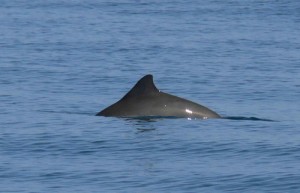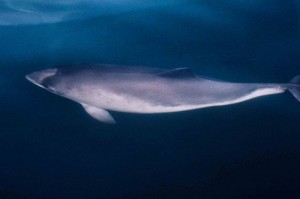On Monday 8th October, myself and the other interns were very happy and lucky to see two harbour porpoises feeding off the pier in New Quay, Wales. We of course love seeing the Bottlenose dolphins, but because harbour porpoises are very shy in nature and do not like being too close to busy harbours or bottlenose dolphins it was a very special sighting. Unsurprisingly it had been a very quiet land watch for the bottlenose dolphins that day. They appeared to be foraging and feeding and there was also a lot of bird associated feeding. It is quite common that cetaceans are spotted where there is a lot of surface activity with feeding birds as this means the water there is potentially abundant with fish. Hot tip for anyone keen on cetacean spotting, look out for feeding sea birds.
Harbour porpoise is the smallest cetacean that can be seen in UK waters. They can grow up to 1.5m in length and weigh up to 60kg. They are rotund in shape and their most disguising feature besides it size is that it has a small grey triangular dorsal fin. They generally can be found in small groups from one to three individuals, however, on occasion they have been seen in groups of 10-20. This seems to happen mostly when they are travelling long distances or in areas of high concentration of food.
The harbour porpoise diet mostly consists of cephalopods and crustaceans, related to what is available in the given area they are. In European waters they have a wide range of fish they feed on for example herring, mackerel, sand-eel and cod. Their seemingly flexible diet helps them to avoid being affected by human over-exploitation of any single fish species. In the extremes of course where intense exploitation of fish stocks happen this can put a great pressure on not only harbour porpoises but all marine mammals that are dependent on fish for food.
They are great creatures and a real treat to see if you are lucky you get a glimpse. They have the nickname ‘puffing pig,’ which if you are lucky enough to hear one blow when they come to the surface this is what they sound like. I hope to see and maybe hear more before the internship ends, I’m keeping my fingers crossed.
By Alex Mozley
Research intern 2018


























